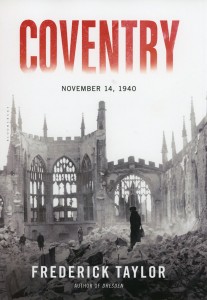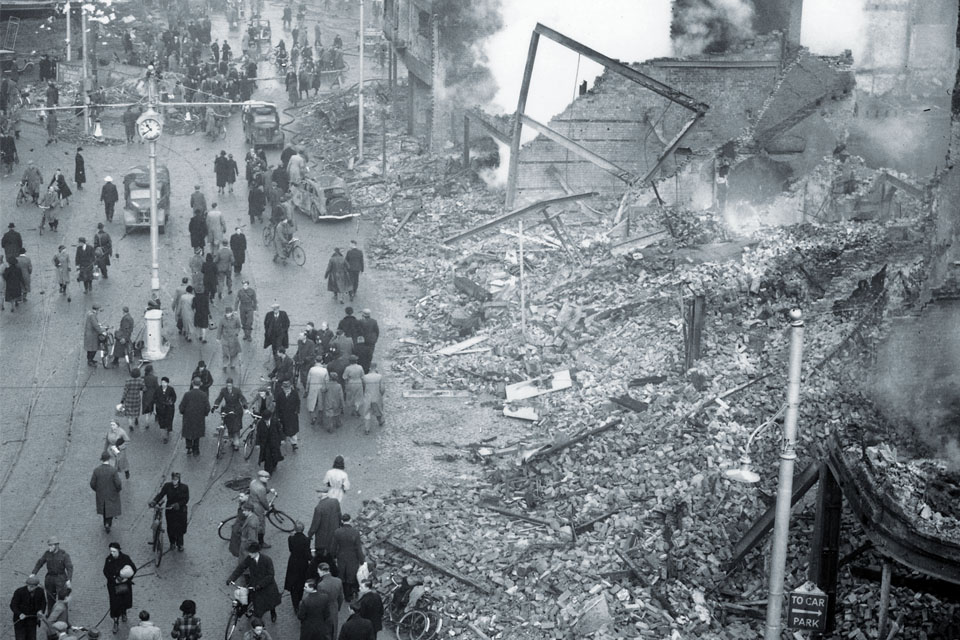COVENTRY
November 14, 1940
By Frederick Taylor. 368 pp.
Bloomsbury, 2016. $30.
[dropcap]I[/dropcap]n 2004, historian Frederick Taylor published the definitive account of the 1945 bombing of Dresden—the climax of the Allied air war against German cities. Taylor echoes that feat with this careful examination of the awful sentence that befell Dresden’s “sister city” in England. The smoking ruins of Coventry’s St. Michael’s Cathedral and those of Dresden’s Frauenkirche came to stand as silent bookends to the European bombing campaigns of World War II.
To set his stage, Taylor unpacks the vivid, varied history of Coventry, home of legendarily unclad Lady Godiva and during both world wars an industrial boomtown. All through the latter conflict the Midlands city endured its fair share of air raids—but only one would be remembered as “the” raid: Operation Moonlight Sonata, which the Luftwaffe undertook the night of November 14-15, 1940. Using advanced navigation and target-finding equipment, hundreds of German bombers attacked Coventry. More than 500 civilians died as conflagrations gutted much of the urban core, a mix of industrial works and residential areas that was dotted with three magnificent churches. The raid and its aftermath profoundly influenced not only military aerial strategy, but also official and unofficial perceptions of civilian morale’s resilience and the limits of what is permissible in modern warfare. A term for destruction, to “Coventrate,” entered the lexicon.
No chronicler of this raid can sidestep the persistent myth that Prime Minister Winston Churchill deliberately sacrificed Coventry for a greater good—namely, that to avoid revealing the success of British codebreaking, Crown authorities deliberately issued no alert. Taylor shows how hollow that claim is. True, intelligence gleaned from broken German ciphers hinted about a raid to come, but those hints arrived late and were ambiguous. Coventry’s residents did receive timely warning, the city’s defenses did mobilize, and the Royal Air Force did follow through with a response that included strikes on Luftwaffe bomber bases and reprisals against German cities—though it must be said, as Taylor does, that the city’s defenders claimed but a single German bomber, the airfield strikes were tardy and ineffective, and a reprisal raid on Berlin amounted to a pinprick.
The retort’s feebleness may have cast Coventry as a sacrificial lamb, but in truth those inadequate gestures were all Britain could muster in late 1940. The hapless city and its citizenry were caught between German night bombing at its apogee and a Britain still consolidating its wartime footing.
But myth and controversy have longer shelf lives than logic, and wartime secrecy and class politics clouded the commemoration of the victims, assessments of civil defense readiness, and even the handling by the media of a visit by King George VI intended to raise morale. Dark rumors still circulate that hundreds of dead civilians lie entombed and unacknowledged in shelters sealed beneath modern Coventry. This book is much more than an anatomy of an air raid; equal parts social history, eyewitness account, and operational analysis, Taylor’s work powerfully portrays a city trapped in the crucible of war.
—Richard R. Muller is a professor of military history at the USAF School of Advanced Air and Space Studies and a regular contributor to World War II.
Originally published in the March/April 2016 issue of World War II magazine. Subscribe here.





